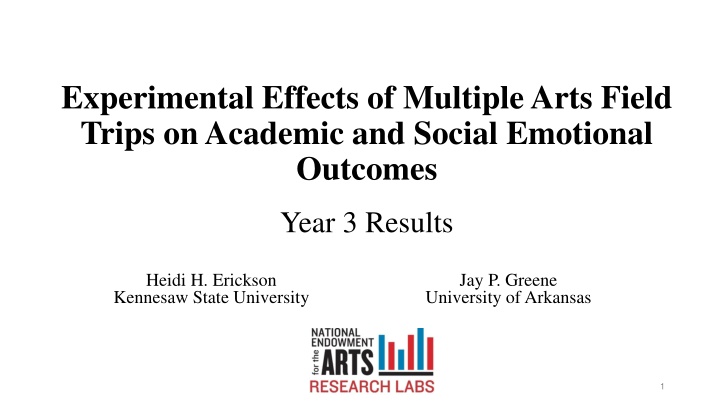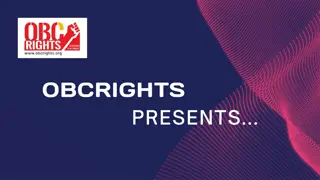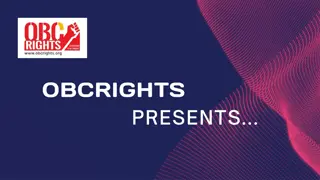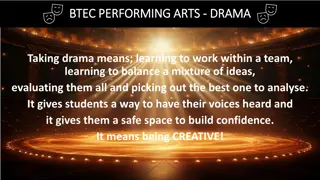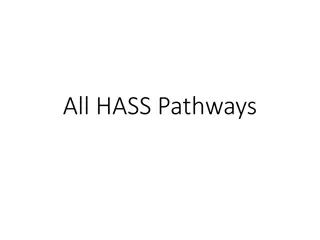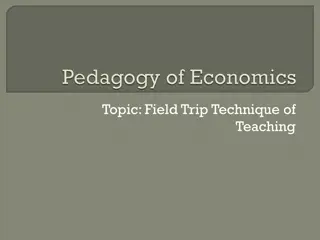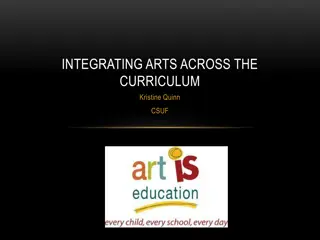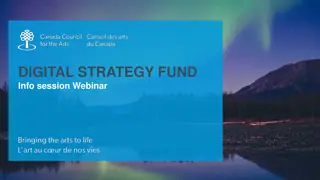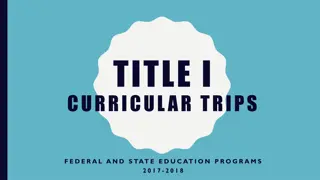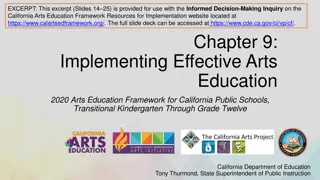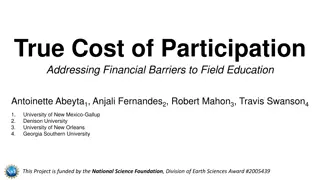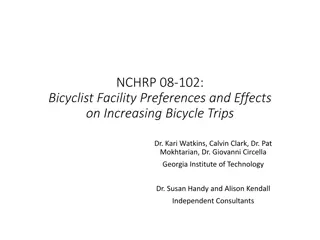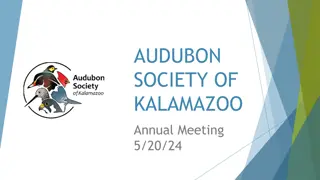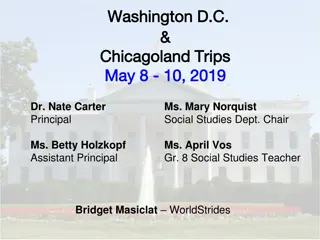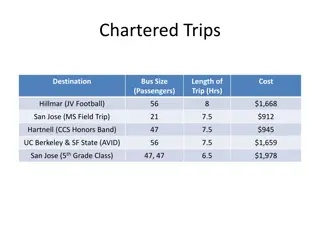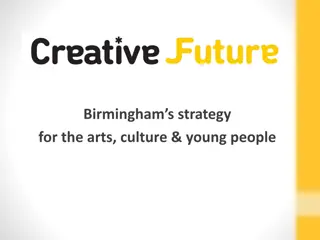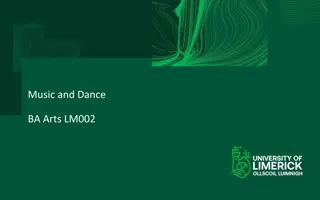Effects of Multiple Arts Field Trips on Academic and Social Outcomes
This study examines the impact of multiple arts field trips on academic and social-emotional outcomes among elementary school students. Findings suggest enhanced academic performance and behavioral outcomes for students participating in culturally enriching field trips to art institutions. The research also highlights the sustained effects of these field trips, particularly as students transition to middle school.
Download Presentation

Please find below an Image/Link to download the presentation.
The content on the website is provided AS IS for your information and personal use only. It may not be sold, licensed, or shared on other websites without obtaining consent from the author.If you encounter any issues during the download, it is possible that the publisher has removed the file from their server.
You are allowed to download the files provided on this website for personal or commercial use, subject to the condition that they are used lawfully. All files are the property of their respective owners.
The content on the website is provided AS IS for your information and personal use only. It may not be sold, licensed, or shared on other websites without obtaining consent from the author.
E N D
Presentation Transcript
Experimental Effects of Multiple Arts Field Trips on Academic and Social Emotional Outcomes d Year 3 Results Heidi H. Erickson Kennesaw State University Jay P. Greene University of Arkansas 1
Disclaimer: The results and opinions expressed here are solely those of the authors and do not necessary represent the views of the Woodruff Arts Center or the National Endowment of the Arts. The NEA does not guarantee the accuracy or completeness of the information included in this material and is not responsible for any consequences of its use. The University of Arkansas NEA research lab is supported in part by a grant award from the Research Labs program at the National Endowment for the Arts (Grant #: 17-3800-7016). 2
Overview Research Question: 1. Do students experience social-emotional and academic benefits from multiple field trips to cultural institutions? 2. Do effects persist over time following treatment? Research Design: Randomly assign 4th and 5th graders at 15 elementary schools to receive 3 culturally enriching field trips throughout the school year and measure the impact on student social-emotional and academic outcomes. High Museum of Art Alliance Theatre Atlanta Symphony Orchestra What we add to previous research: 1. Experimental design - what is the CAUSAL effect of arts-focused fieldtrips. 2. Multiple trips to 3 different art institutions 3. Large, urban school district serving primarily minority and low-income students 4. Longitudinal study - follow students after they experience treatment 3
Overview Findings We find no effect on students desire to participate in the arts nor on social emotional measures of empathy, social perspective taking, and political tolerance Treatment students have a higher desire to consume arts in the future Treatment students have higher levels of tolerance Intervention seems to affect students behavior and academic outcomes most when they enter middle school Treatment students experience higher test scores, higher course grades, fewer behavioral infractions, and fewer absences First study to show increased effect from multiple fieldtrips and sustained effects past treatment 4
Motivation: Evidence of cultural field trips declining Increase in schools canceling field trips (Ellerson & McCord, 2009) Teachers report decline in arts education and field trips, particularly among disadvantaged students (Government Accountability Office, 2009) Principals reported pressure from accountability standards and tight budgets Cultural institutions report fewer student groups attending and that adult attendance at art institutions is also declining (Rabkin & Hedberg, 2010) 5
Previous literature Observational studies Student involvement in the arts is associated with higher academic performance (Ludwig, Boyle, & Lindsay, 2017; J gar and M llegarrd, 2017; Ruppert, 2006; ) Students who attend cultural institutions experience academic and social emotional benefits in the short term (Lacoe, Painter, & Williams, 2016; RK&A, 2018) Experimental studies (GOLD Standard) Students experience an increase in tolerance, critical thinking, empathy, content knowledge, and desire to consume art from visiting art museums or theater (Bowen, Greene, & Kisida, 2014; Greene et al, 2018; Greene et al., 2014; Kisida, Greene, & Bowen, 2014) Students in an arts integration program demonstrated reduced discipline, increased writing test scores, and increased compassion (Bowen & Kisida, 2019) 6
Research Question Research Question: 1. Do students experience social emotional and academic benefits from multiple field trips to cultural institutions? 2. Do effects persist over time following treatment? Hypotheses Expect positive gains in social emotional constructs such as tolerance and social perspective taking Expect positive gains in student desire to consume arts Expect no significant effect in academic achievement 7
Research Design: Randomized Control Trial Treatment Group: Field trips to each of the Woodruff Arts Center art partners High Museum of Art Atlanta Symphony Orchestra Alliance Theater Control Group: Business as usual Follow-up Survey in Spring 4th & 5th Grade Randomized Survey in Fall 3 Field Trips 8
Research Design: Randomized Control Trial Treatment Assignment School 5 4th Treatment 5th Control 6th Treatment- 1yr post School 6 4thTreatment 5th Control 6th Treatment- 1yr post School 7 4th Treatment 5th Control 6th Treatment- 1yr post School 1 School 11 We estimate the effect of: 3 field trips in 1 year 6 field trips in 2 years 1 year following treatment 2 years following treatment 4th Treatment 5th Control 6th Treatment- 1yr post 7thTreatment- 2yr post School 2 4th Treatment 5th Control 6th Treatment- 1yr post 7thTreatment- 2yr post School 3 4th Control 5th Treatment- double dose School 8 6th Control 7thControl School 4 4th Control 5th Treatment- double dose 6th Control 7thControl 4th Treatment 5th Control School 12 4th Treatment 5th Control School 13 4th Treatment 5th Control School 14 4thControl 5th Treatment- double dose 6th Control School 9 4thControl 5th Treatment- double dose 6th Control School 10 4thControl 5th Treatment- double dose 6th Control 4th Control 5th Treatment School 15 4th Control 5th Treatment Cohort 1 Cohort 2 Cohort 3 9
Data 15 elementary schools in a large urban school district Approximately 2,000 Students Student Surveys Interest in art consumption and participation Social emotional measures School engagement Administrative records Georgia Milestones Courses & grades Attendance Discipline records 10
Results: Art Consumption & Tolerance Tolerance: I believe people can have different opinions about the same thing. Desire to Consume Art: Combined scale of desire to attend art museums, symphony performances, and live theater when students are older. Treatment Effect of Students Desire to Consume Art and Tolerance 0.16 ** 0.135 0.14 0.12 Treatment students report greater levels of tolerance by 13.5% of a standard deviation than control students * 0.091 0.1 0.08 Treatment students have a higher desire to consume the arts by 9.1% of a standard deviation than control students 0.06 0.04 0.02 0 Desire to Consume Art Tolerance Notes: *** p<0.01, ** p<0.05, * p<0.1 Results are shown in standard deviation effect sizes. First Treat indicates if a student received treatment in one year, and Second Treat indicatores if a student received treatment two year in a row. 11
Summary: Art Consumption & Tolerance Treatment students express a greater desire to consume arts in the future than control group students Treatment students also express greater tolerance, believing people can have different opinions about the same thing, than control group students Treatment effects are only measured in the same year as treatment We only have survey data from all 3 cohorts in the first year of treatment We see no effect on other social emotional outcomes such as empathy, social perspective taking, and political tolerance Evidence that students had difficulty understanding questions on the survey Finding no effect doesn t mean that the treatment did not affect students on these outcomes, but that we may be unable to detect the effect 12
Results: Behavioral Outcomes Treatment Effect on Behavioral Infractions Treatment Effect on Student Absences 0.15 0.8 0.6 0.088 0.1 0.6 0.05 0.047 0.05 0.4 0.2 0 0.2 First Treat Second Treat 1 yr post 2 yr post -0.05 0 Treatment students have .2 infractions less than control students once students enter middle school First Treat Second Treat 1 yr post 2 yr post -0.1 -0.1 -0.2 Treatment students are .6 percentage points less absent that control students -0.4 -0.15 -0.6 -0.2 ** -0.192 ** -0.6 -0.8 -0.25 Notes: *** p<0.01, ** p<0.05, * p<0.1 Results are shown in standard deviation effect sizes. Georgia Milestone scores as well as course grades were standardized within grade level. First Treat indicates if a student received treatment in one year, and Second Treat indicatores if a student received treatment two year in a row. 13
Summary: Behavioral Outcomes We find significant behavioral differences between treatment and control group students once they enter middle school Treatment students have fewer infractions and are absent less often than control students The pattern across treatment conditions is mixed Prior to 6th grade, students have few reported infractions Treatment effect estimates are imprecise 14
Results: Academic Outcomes Treatment Effect on Georgia Milestones Treatment Effect on Course Grades 0.25 0.12 0.228 *** *** 0.105 0.1 Treatment students earn higher grades than control students by 22.8% of a standard deviation 0.2 Treatment students score 10.5% of a standard deviation higher than control students on end of year tests 0.08 0.15 0.06 0.094 0.1 0.04 0.031 0.03 0.042 0.05 0.02 0.005 0.002 0 0 First Treat Second Treat 1 yr post 2 yr post First Treat Second Treat 1 yr post 2 yr post Notes: *** p<0.01, ** p<0.05, * p<0.1 Results are shown in standard deviation effect sizes. Georgia Milestone scores as well as course grades were standardized within grade level. First Treat indicates if a student received treatment in one year, and Second Treat indicatores if a student received treatment two year in a row. 15
Summary: Academic Outcomes We find significant test score and course grade differences between treatment and control students once they enter middle school Treatment students score higher on the Georgia Milestone end of grade exams and have higher course grades than control group students The pattern across treatment conditions is consistent Some evidence that these effects may be concentrated in cohort 1 students 16
Takeaways First experimental study to find positive effects on student behavioral and academic outcomes from attending arts-focused field trips First study to show effects multiple years past treatment Some evidence that treatment effects are concentrated for students in cohort 1 The treatment is a relatively low-touch intervention, so the fact that we see positive results is significant Next Steps Inside the Black Box: Understanding teacher and student experiences with field trips Teacher focus groups Working with a handful of schools in the study to better understand teachers perspective of the intervention Student interviews Talking with students to understand how the intervention impacted them beyond what we capture in survey data 17
Thank You Questions or Comments Heidi H. Erickson hholme11@Kennesaw.edu Jay P. Greene jpg@uark.edu 18
Supplementary Information 19
Sample Survey Items: Art Consumption If your friends or family wanted to go to an art museum, how interested would you be in going? Visiting art museums is fun. I plan to visit art museums when I am an adult. Art is interesting to me. I feel like I don t belong when I m at an art museum. I feel comfortable talking about art. I would tell my friends that they should visit an art museum. Do you think your friend would enjoy a field trip to an art museum (such as the High Museum of Art)? 20
Sample Survey Items: Social Perspective Taking How often do you attempt to understand your friends better by trying to figure out what they are thinking? How often do you try to think of more than one explanation for why someone else acted as they did? Overall, how often do you try to understand the point of view of other people? How often do you try to figure out what emotions people are feeling when you meet them for the first time? In general, how often do you try to understand how other people view the situation? 21
